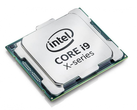Intel Xe is the name for this company's anticipated foray into discrete graphics. It is thought that these products may have the potential to disrupt the current dichotomy of the GPU market, in which NVIDIA and AMD are all but unpassable. Today (May 1, 2019), Intel's Advanced Rendering and Visualization division's senior director and senior principal engineer, Jim Jeffers, poured more fuel on this fire of speculation.
Jeffers has given more details on Xe graphics and what they may be capable of in an official release. It includes the statement: "I’m pleased to share today that the Intel® Xe architecture roadmap for data center optimized rendering includes ray tracing (RT) hardware acceleration support"
Therefore, it seems the Xe line is indeed intended to compete directly with the NVIDIA RTX series, with their own Turing architecture for the same functionality. On the other hand, Intel is not targeting the gaming market with its apparent new RT abilites (or not right now, rather). The XE graphics solution has been designed to support the company's Rendering Framework, which is also associated with Xeon scalable processors.
This hardware and software is distinctly directed at the high-volume, high-stakes data-center market, inhabited by the likes of Pixar and other major studios. They also need ray-tracing to produce their top-flight animation sequences; however, doing this via CPU alone is less than ideal. XE graphics, on the other hand, could expedite these applications with quantum leaps in efficacy.


 Deutsch
Deutsch English
English Español
Español Français
Français Italiano
Italiano Nederlands
Nederlands Polski
Polski Português
Português Русский
Русский Türkçe
Türkçe Svenska
Svenska Chinese
Chinese Magyar
Magyar



















